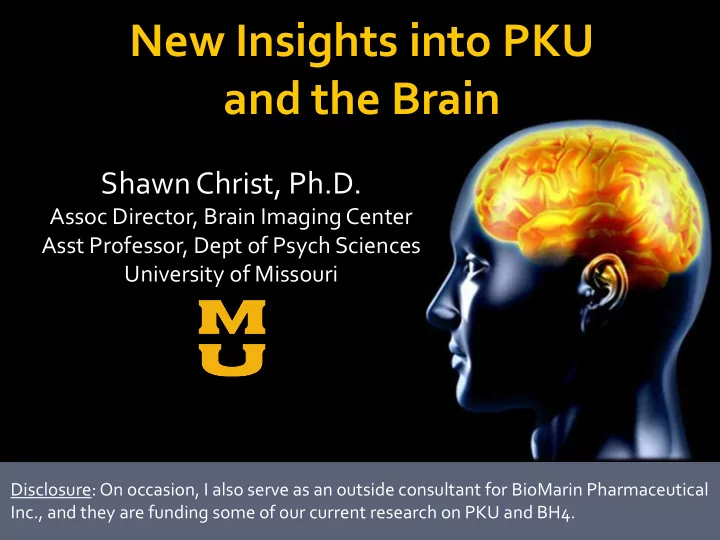

New Insights into PKU and the Brain Shawn Christ, Ph.D. Assoc Director, Brain Imaging Center Asst Professor, Dept of Psych Sciences University of Missouri Disclosure: On occasion, I also serve as an outside consultant for BioMarin Pharmaceutical Inc., and they are funding some of our current research on PKU and BH4.
The help & support of individuals and families such as you makes our work possible.
Neurocognitive Model of PKU Review of Past Research Cognitive & Behavioral Findings Structural Brain Findings Our Current Research Functional brain activation & connectivity Conclusions & Future Directions http://clinicalneurolab.missouri.edu/Vancouver2012.pdf
Phenylalanine Phenylalanine Hydroxylase (PAH) absent or mutated Tyrosine Dopamine & other neurotransmitters
frontal lobe prefrontal cortex dopamine pathways
Thinking Disruption of PAH Brain Skills, Dopamine Deficiency Disruption Emotions, & System Behavior Past & Current Treatment Patient Environment & Resources Christ (in prep)
Neurocognitive Model of PKU Review of Past Research Cognitive & Behavioral Findings Structural Brain Findings Our Current Research Functional brain activation & connectivity Conclusions & Future Directions
Thinking PAH Skills, Deficiency Emotions, & Behavior Past & Current Treatment
ETPKU associated with increased risk of: Slight decrease in overall intellectual ability Executive function problems Slowed processing speed Difficulties with anxiety & depression
50 Non-PKU (n = 181) % of Individuals Reporting Problems PKU (n = 35 40 37% 31% 30 19% 20 16% 14% 14% 10 6% 5% 5% 1% 0 Depressed Mood Phobias Generalized Hypochondriac Anxiety at Work Anxiety Worries Pietz et al. (1997)
ETPKU associated with increased risk of: Slight decrease in overall intellectual ability Executive control problems Slowed processing speed Difficulties with anxiety & depression Impact may be moderated by: Timing of treatment (earlier = better) Adherence to diet (stricter = better) Consistency of treatment (stable = better)
Neurocognitive Model of PKU Review of Past Research Cognitive & Behavioral Findings Structural Brain Findings Our Current Research Functional brain activation & connectivity Conclusions & Future Directions
PAH Brain Deficiency Disruption
Major Tissue Distinction Gray Matter – Brain areas where ‘data processing’ occurs White Matter – Insulated ‘wires’ connecting different brain areas with each other.
Complex behavior relies on a host of underlying processes that are each carried out in a single region of brain. In other words, complex behavior relies on a network of brain regions.
Periventricular Abnormalities
Periventricular Abnormalities >90% of adults with PKU have visible abnormality Anderson & Leuzzi (2010)
Periventricular Abnormalities >90% of adults with PKU have visible abnormality Anderson & Leuzzi (2010)
Peng, Peck, White & Christ (in press)
Peng, Peck, White & Christ (in press)
Structural Integrity vs. Functional Integrity Are the physical brain regions How well do spatially distinct and/or their connections regions work together to damaged or otherwise support complex cognitive atypical? functions? ???
Neurocognitive Model of PKU Review of Past Research Cognitive & Behavioral Findings Structural Brain Findings Our Current Research Functional brain activation & connectivity Conclusions & Future Directions
Thinking PAH Brain Skills, Deficiency Disruption Emotions, & Behavior
Christ, S. E., Moffitt, A., & Peck, D. (2010). Disruption of prefrontal function and connectivity in individuals with phenylketonuria. Molecular Genetics & Metabolism, 99 , S33-40.
Christ et al. (2010)
0-Back K J X 2-Back N G N P Christ et al. (2010)
Age FSIQ N M SD M SD PKU 6 18.3 4.9 107.7 14.2 Control 6 17.8 5.9 116.2 11.4 • Mean blood Phe level at the time of study was 9.98 mg/dL (SD = 7.8) • No medical hx unrelated to PKU • Recruited from Columbia, Missouri area Christ et al. (2010)
z = 51 z = 50 z = 0 Christ et al. (2010)
Evaluated by looking at the degree of concordance in neural activity among networked brain regions Disrupted in several other clinical populations: autism, schizophrenia, depression, etc. Strength of functional connectivity positively correlated with cognitive performance (Hampson et al, 2006) Christ et al. (2010)
Left SFG z = 53 Left IFG z = 33 Christ et al. (2010)
Christ et al. (2010)
from Fox et al. (2005)
From Buckner & Carroll (2007)
Christ et al. (JIMD, 2012)
Christ et al. (JIMD, 2012)
Neurocognitive Model of PKU Review of Past Research Cognitive & Behavioral Findings Structural Brain Findings Our Current Research Functional brain activation & connectivity Conclusions & Future Directions
Structural Integrity vs. Functional Integrity Are the physical connections How well do spatially distinct (pathways) between regions regions work together to damaged or otherwise support complex cognitive atypical? functions?
Structural Integrity vs. Functional Integrity ***IMPORTANT*** Are the physical connections How well do spatially distinct Evidence that these effects are (pathways) between regions regions work together to damaged or otherwise moderated by phe levels!!! support complex cognitive atypical? functions?
Why are some individuals more affected than others?
Why are some individuals more affected than others? Are these problems reversible with treatment? Our current research looking at the effects of BH4 treatment on cognition & the brain in PKU
Shawn Christ christse@missouri.edu http://clinicalneurolab.missouri.edu http://clinicalneurolab.missouri.edu/Vancouver2012.pdf
Recommend
More recommend